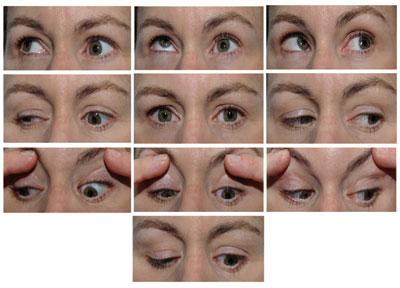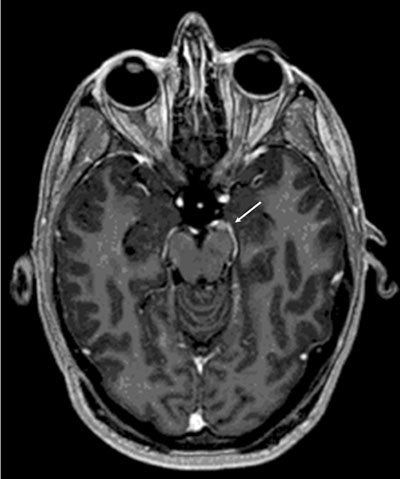Woman referred for persistent diplopia
Episodes of diplopia would occur after severe migraine headaches.
 Priti Batta |
 Namrata Nandakumar |
A 46-year-old woman was referred to the New England Eye Center for evaluation of diplopia. Since childhood she had experienced episodes of severe migraine headaches followed by ptosis of the left upper eyelid and binocular diplopia. The episodes would occur about once per year with the diplopia lasting for 2 to 3 days. After an episode 3 years ago, however, the diplopia persisted. She denied any other neurological symptoms or history of trauma.
Her ocular history was significant for patching of the left eye as a child and a presumptive diagnosis of ophthalmoplegic migraines. Her medical history, social history and review of systems were unremarkable.
Examination
The patient’s best corrected distance visual acuity was 20/20 in the right eye and 20/25 in the left eye. The left pupil was 1 mm larger than the right and was less reactive. Mild ptosis of the left upper lid was noted. Color testing by Ishihara color plates was full in both eyes. The patient identified four out of nine circles on Titmus stereopsis testing.
The patient had a right head turn with slight right tilt. Motility of the left eye revealed limitation in elevation, depression and adduction. There was retraction of the left eyelid on downgaze (Figure 1). Motility of the right eye was full. Slit lamp exam of the anterior and posterior segments was unremarkable.
 Figure 1. Motility photos demonstrating limitation of elevation, adduction and depression of the left eye. Also note retraction of the left eyelid on downgaze and adduction of the left eye on attempted upgaze. Images: Carmody JN, Strominger MB
|

What is your diagnosis?
Worsening binocular diplopia
A third nerve palsy with aberrant regeneration can be secondary to nerve trauma, compression by an aneurysm or compression by a tumor (meningioma or schwannoma). Aberrancy can also be seen in congenital cases of oculomotor nerve palsy.
The patient underwent an MRI with gadolinium, which revealed a 5 mm × 5 mm × 6 mm homogenously enhancing mass along the left third nerve at the cistern, consistent with a third nerve schwannoma (Figure 2).
 Figure 2. T2 weighted MRI with gadolinium showing a 5 mm x 5 mm x 6 mm homogenously enhancing mass along the left CN 3 in the cistern. |
Discussion
Schwannomas account for 7% of all intracranial tumors and typically involve CN 5 or CN 8. There are less than 50 reported cases of oculomotor nerve schwannomas in the literature. There are no apparent age or sex predilections.
Third nerve schwannomas typically present as a chronic, progressive third nerve palsy with headache, but they may be asymptomatic. The size of the lesion does not seem to correlate with symptoms.
The most common location for a third nerve schwannoma is in the cistern. On MRI (T1 or T2), the lesion appears isointense or hypointense in comparison to the brainstem. If there are cystic changes, the T2 signal intensity is increased. The lesion enhances with gadolinium.
Treatment of an oculomotor nerve schwannoma is limited. There is a high risk of permanent nerve injury with surgical resection. The majority of studies have been unable to demonstrate improvement in symptoms after surgical resection, and in many cases there can be worsening of initial symptoms. Surgical resection is therefore only indicated for large tumors with intractable symptoms. A second treatment option is gamma knife radiotherapy, which has been successful in the treatment of CN 8 schwannomas. A small case series evaluating gamma knife radiotherapy for the treatment of CN 3 schwannomas showed stability and no worsening of symptoms over 3.5 years.
Treatment and follow-up
The patient was prescribed a pair of prism glasses to help alleviate her diplopia. She was referred to neurosurgery for discussion of possible treatment options.
The patient underwent gamma knife radiotherapy to try to prevent progression of the third nerve palsy. Three months after gamma knife radiotherapy, the third nerve palsy was stable, and the diplopia was almost completely resolved with the prism glasses.
References:
- Bisdorff AR, Wildanger G. Oculomotor nerve schwannoma mimicking ophthalmoplegic migraine. Cephalalgia. 2006;26(9):1157-1159.
- Kawasaki A. Oculomotor nerve schwannoma associated with ophthalmoplegic migraine. Am J Ophthalmol. 1999;128(5):658-660.
- Kim IY, Kondziolka D, Niranjan A, Flickinger JC, Lunsford LD. Gamma knife surgery for schwannomas originating from cranial nerves III, IV, and VI. J Neurosurg. 2008;109 Suppl:149-153.
- Lingawi SS. Oculomotor nerve schwannoma: MRI appearance. Clin Imaging. 2000;24(2):86-88.
- Ohata K, Takami T, Goto T, Ishibashi K. Schwannoma if the oculomotor nerve. Neurol India. 2006;54(4):437-439.
- Prabhu SS, Bruner JM. Large oculomotor schwannoma presenting as a parasellar mass: A case report and literature review. Surg Neurol Int. 2010;1:15.
- Riadh H, Mohamed G, Salah Y, Fehmi T, Fafani BH. Pediatric case of ophthalmoplegic migraine with recurrent oculomotor nerve palsy. Can J Ophthalmol. 2010;45(6):643.
- Jill N. Carmody, MD, and Mitchell B. Strominger, MD, can be reached at New England Eye Center, Tufts University School of Medicine, 750 Washington St., Box 450, Boston, MA 02111; 617-636-4219; fax: 617-636-4866; website: www.neec.com.
- Edited by Priti Batta, MD, and Namrata Nandakumar, MD. Drs. Batta and Nandakumar can be reached at New England Eye Center, Tufts University School of Medicine, 750 Washington St., Box 450, Boston, MA 02111; 617-636-4219; fax: 617-636-4866; website: www.neec.com.

